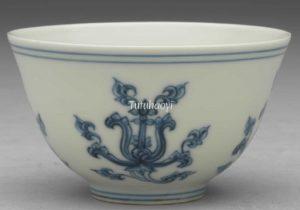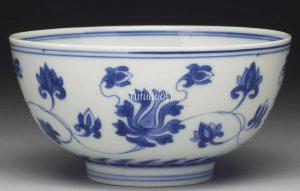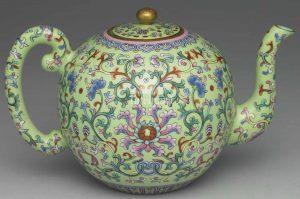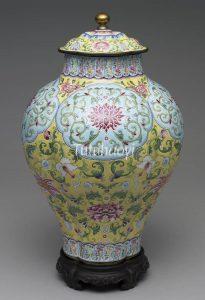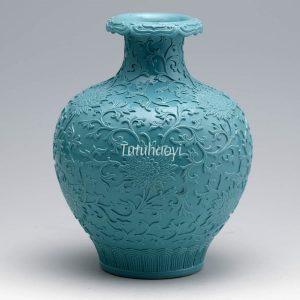Passion Flower
宝相花
© Tutuhaoyi.com owns the copyright of the description content for the images attached. Quoting all or part of the description content on this page is permitted ONLY IF ‘Tutuhaoyi.com’ is clearly acknowledged anywhere your quote is produced unless stated otherwise. (本页描述内容版权归Tutuhaoyi.com所有,转发或引用需注明 “Tutuhaoyi.com”, 侵权必究, 已注开源信息的条目除外。)
The ‘Baoxiang 宝相’ pattern is a Buddhist motif created through artistic processing based on the shapes of flowers, flower buds, and leaves found in nature. The main subjects of the Baoxiang pattern are peonies, lotus flowers, and other similar elements, which have gradually evolved over time. The Baoxiang pattern is also known as ‘Baoxianhua 宝仙花’, ‘Baolianhua 宝莲花’, or ‘xifanlian 西番莲’, which literally means ‘western passion flower’. Due to its luxurious and ornate appearance, it is referred to as ‘Baoxianghua’. The name carries auspicious meanings of wealth and fulfillment, symbolising prosperity and happiness.
Fig 1: porcelain cup with underglaze blue decoration, Chenghua period (1465–87), Ming dynasty, courtesy of the National Palace Museum, Taipei
Fig 2: porcelain bowl with underglaze blue decoration, Kangxi period (1662–1722), Qing dynasty, courtesy of the National Palace Museum, Taipei
Fig 3-4: famille rose teapot, Qianlong period (1736–95), Qing dynasty, courtesy of the National Palace Museum, Taipei
Fig 5: porcelain bowl, 1741, Qianlong period (1736–95), Qing dynasty, courtesy of the National Palace Museum, Taipei
Fig 6: porcelain vase, 1742, Qianlong period (1736–95), Qing dynasty, courtesy of the National Palace Museum, Taipei
Fig 7: porcelain vase, 1743, Qianlong period (1736–95), Qing dynasty, courtesy of the National Palace Museum, Taipei
Fig 8: famille rose porcelain hat stand, Qianlong period (1736–95), Qing dynasty, courtesy of the National Palace Museum, Taipei
Fig 9: long-necked ovoid vase with floral scroll over blue ground, Qianlong period (1736–95), Qing dynasty, courtesy of the Museum of Fine Arts, Boston
Fig 10: glass snuff-bottle with enamelled decoration, Qianlong period (1736–95), Qing dynasty, courtesy of the National Palace Museum, Taipei
Fig 11: porcelain vase, Qianlong period (1736–95), Qing dynasty, courtesy of the Art Institute of Chicago
Fig 12: copper lidded jar with enamelled decoration, Qianlong period (1736–95), Qing dynasty, courtesy of the National Palace Museum, Taipei
Fig 13: porcelain vase, Qianlong period (1736–95), Qing dynasty, courtesy of Shanghai Museum, China
Fig 14: porcelain wall vase, Jiaqing period (1796–1820), Qing dynasty, courtesy of the National Palace Museum, Taipei
Fig 15: porcelain vase, Jiaqing period (1796–1820), Qing dynasty, courtesy of the National Palace Museum, Taipei
Fig 16: porcelain basin, Qing dynasty (1644–1911), courtesy of the National Palace Museum, Taipei
